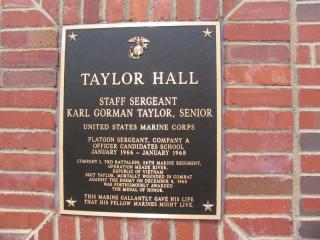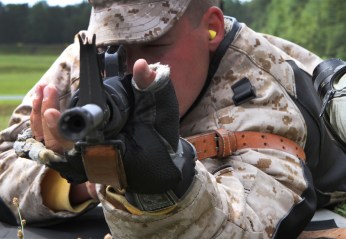Marine Corps First Lieutenant Agustin Solivan briefs members of the news media at the National Museum of the Marine Corps, near the Marine Corps Base Quantico in Quantico, Virginia on March 22, 2013.
The double-murder suicide at the Quantico Marine base 35 miles south of Washington comes as a shock. It stuns, not only because one Marine apparently used a gun to kill two others, and then himself, but because the nation counts on its highly-trained armed forces – with the emphasis on armed – to use its weapons only in carefully prescribed ways.
“A fatal shooting occurred at Officer Candidate School around 11 p.m. on March 21,” the Marines said in a terse statement. “The shooter, an active-duty Marine, has been pronounced dead of an apparent self-inflicted gunshot wound by law enforcement at the scene. Two other victims, also active-duty Marines, were pronounced dead at the scene.”
All three were staffers at the school – not potential officers there for training, Marine officials said. The assailant shot and killed one male Marine in the Taylor Hall barracks before seizing a female Marine and then killing her and himself.
Any motive remains unknown. The names of those killed won’t be released for 24 hours or until their next of kin is notified.
The base was on lockdown for several hours following the shooting.
“This is truly a tragic loss for the Marine Corps, which has had a number of tragic losses in the last couple of weeks,” base commander Colonel David Maxwell told reporters early Friday.
Unlike the tragedy in Nevada on Monday, where seven Marines died after a mortar round exploded prematurely, the overnight killings at Quantico were not an accident. That depresses Marines more than anything: that someone inside this elite band of warriors could turn on his own.
Quantico – known as the Crossroads of the Corps – has a total population of about 12,000 and occupies nearly 100 square miles. It could also be known as the classroom of the corps, home to Officer Candidates School where the killings took place. That’s the path followed by most Marine officers. They are screened and trained for leadership billets in the corps over several weeks of courses, including field exercises, before being commissioned as 2nd lieutenants. The base also houses Marine Corps University, the corps’ Combat Development Command, its War-fighting Laboratory, as well as the National Museum of the Marine Corps and the Marine Corps Brig.
Military violence unrelated to war surfaced at a House Armed Services Committee hearing Thursday, looking into suicide in the military’s ranks, and the role potentially played by service members’ relatively easy access to firearms. The Pentagon takes the threat of suicide by gun seriously enough that it has distributed more than 75,000 gun locks to its forces.
Those in uniform “have perhaps access to guns at a greater level than in the general population,” Rep. Susan Davis, D-Calif., said. “We have the literature indicating that restricting access to means — firearms, of course — is an effective strategy for preventing suicides.”
The Pentagon’s top suicide fighter said recent guidance from Congress has made it easier for the military services to inquire about military personnel’s personal firearms. Recently-passed legislation “just gave us some really good clarifying language on who can and when can you ask about personally owned firearms, ammunition and other weapons,” Jacqueline Garrick, chief of the Defense Suicide Prevention Office, told the panel’s personnel subcommittee. “We are working on a guidance for that so that we can get that information out to the services and make sure that everybody that the clinicians as well as the commanders are tracking that on what you can do. So I think that was an important step for us.”
The Army’s top personnel officer says the new legislation will help keep tabs on personal weapons that may contribute to the military’s suicide toll. “Commanders sort of have the authority to get in what I call almost that invasive leadership,” Lieut. General Howard Bromberg said. The congressional guidance “did help us significantly by opening up the aperture for those that live off post or off the installation so we can ask the right questions to try to retrieve those weapons,” he added. “The commands are going after that very aggressively.”
It is not known yet whether the firearm used in the Quantico killings was the killer’s personal weapon.
The Army’s former top psychiatrist, who has questioned the easy access to firearms by members of the military, says that the issues that drive suicide in the ranks also can cause murder-suicides. “It’s too early to know what prompted this shooting,” says Dr. Elspeth Ritchie, who regularly contributes to Battleland. “But when we’ve looked at other murder-suicides, they often have the same dynamics as suicide itself – it’s often an action stemming from humiliation or a broken relationship — and easy access to lethal firearms.”




